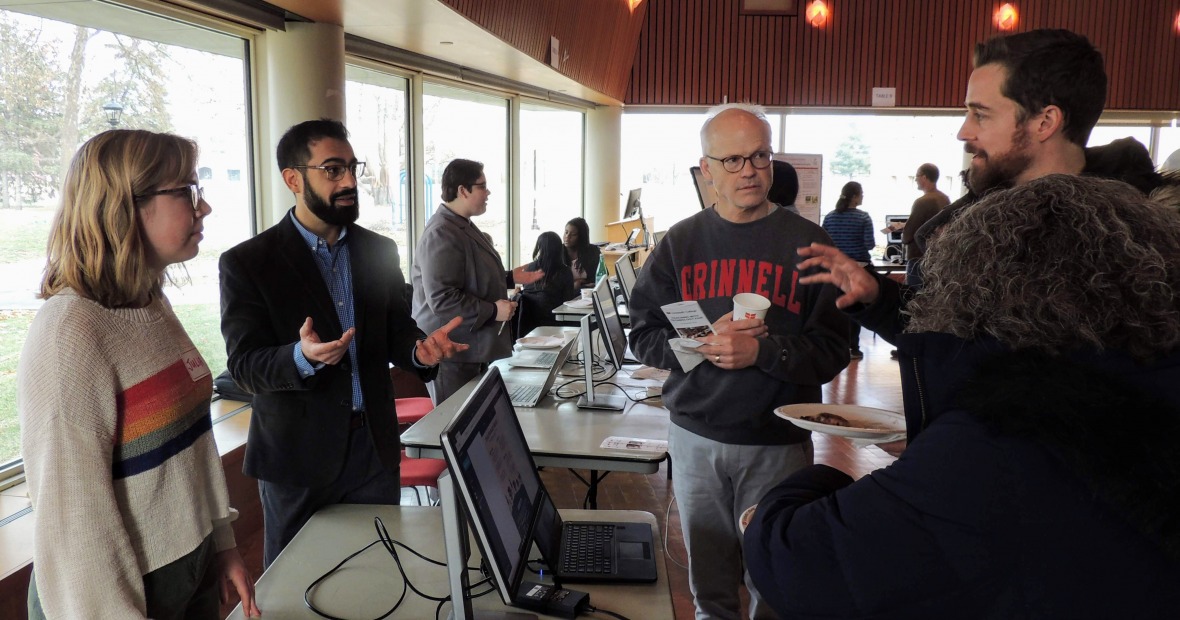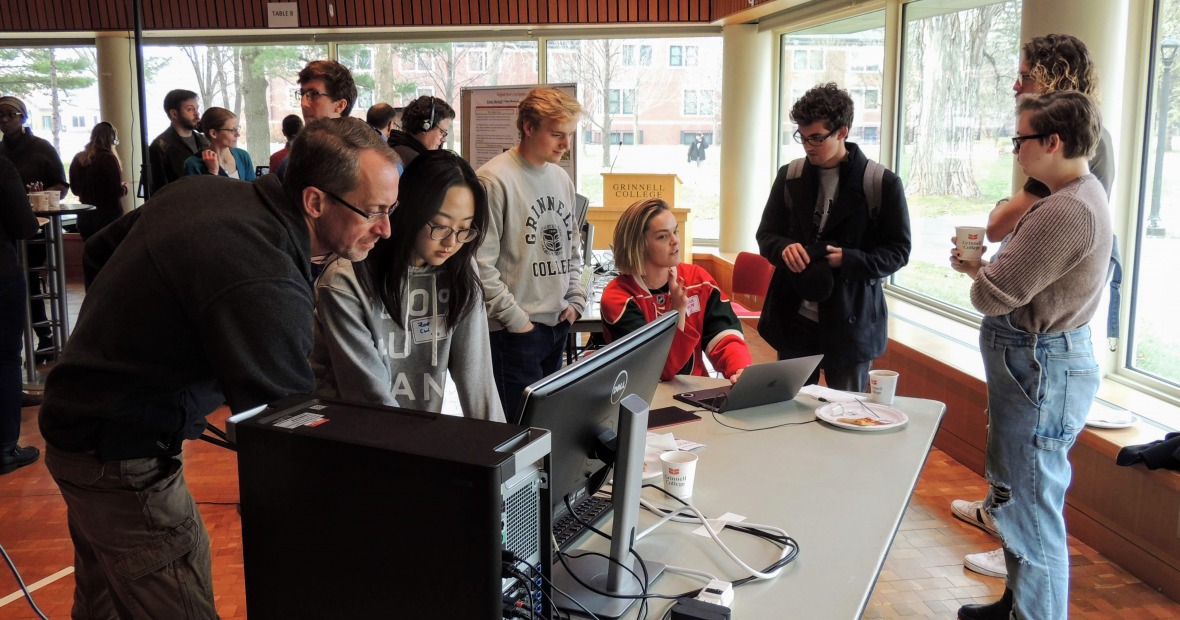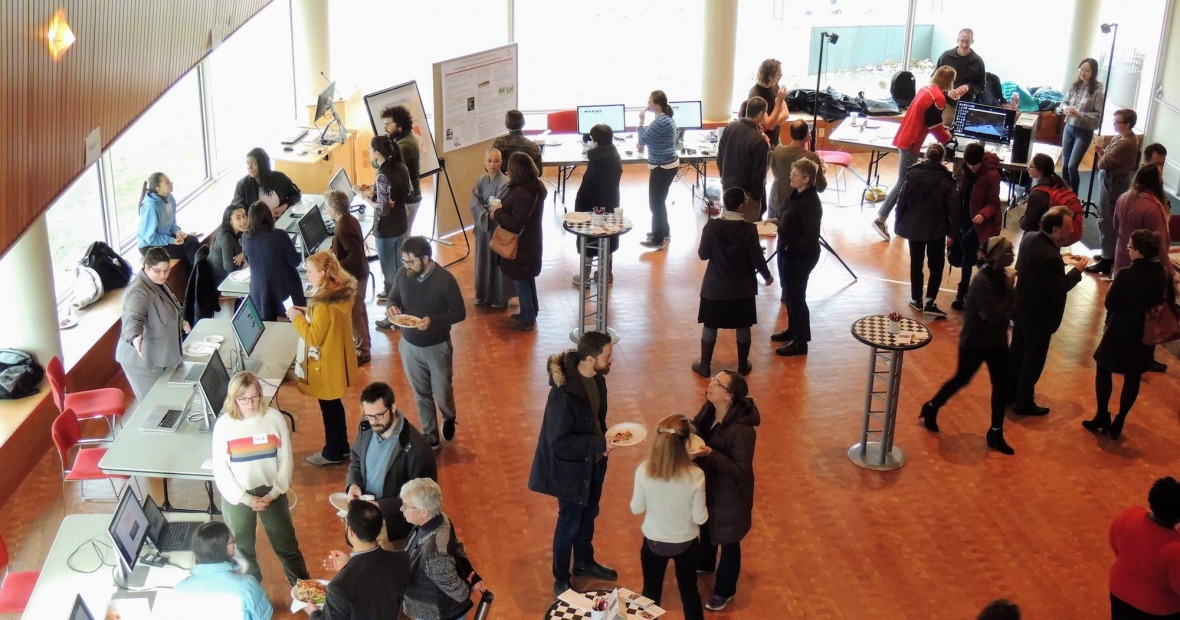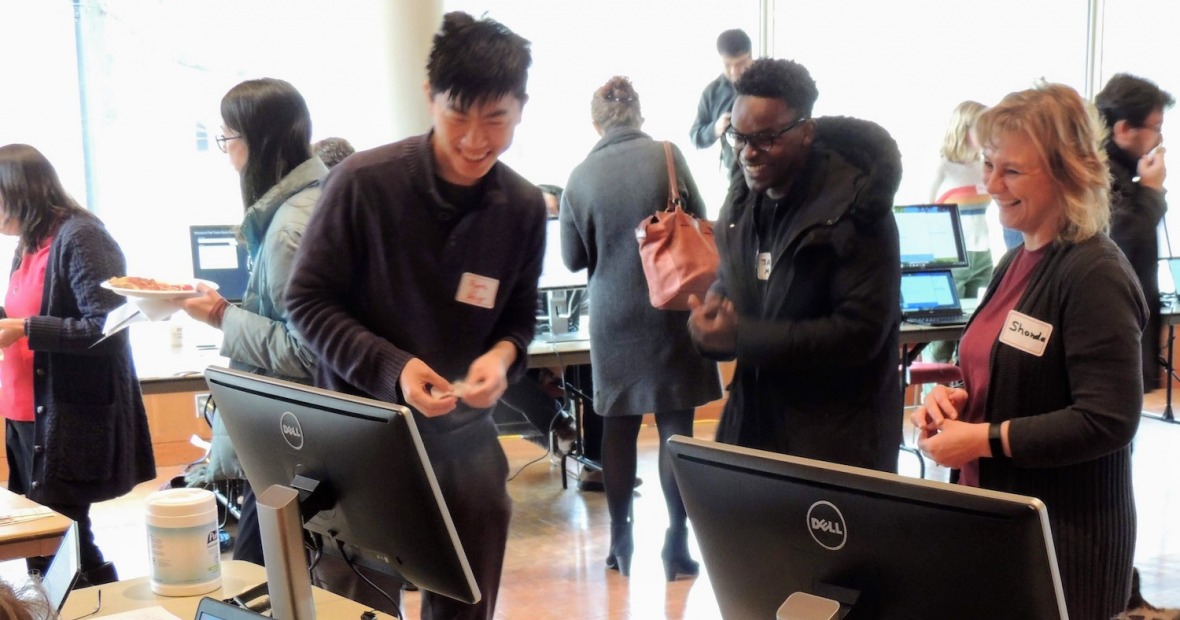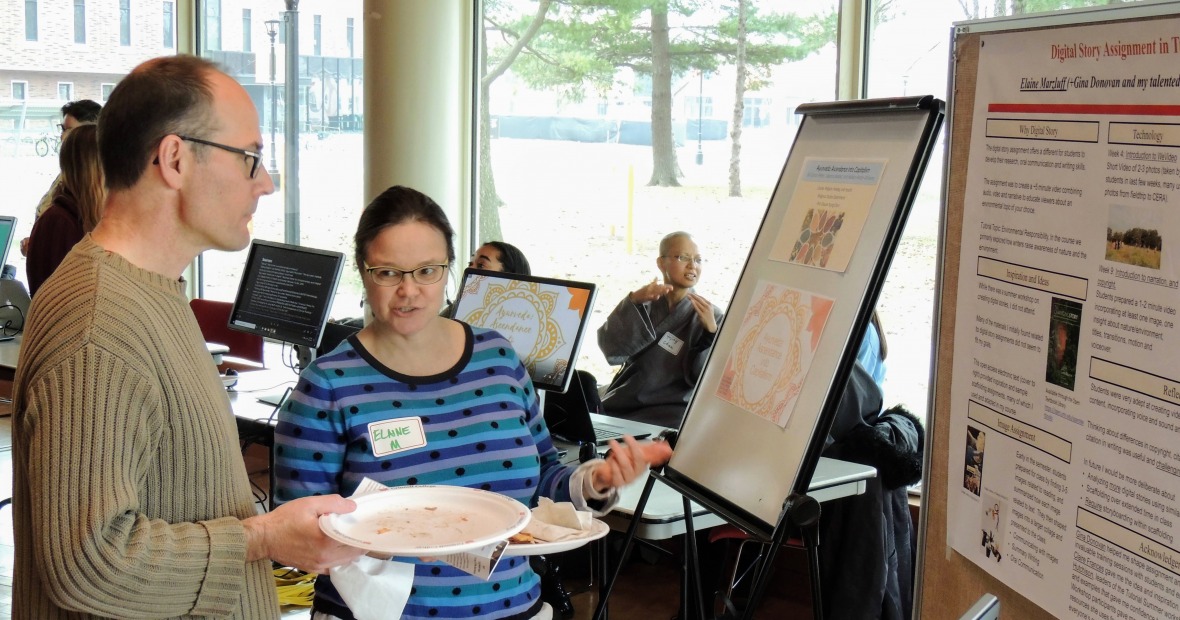Faculty and Student Projects Showcased in 2019 Teaching with Technology Fair
On Friday December 13, the Digital Liberal Arts Collaborative (DLAC) and the Center for Teaching, Learning, and Assessment (CTLA) hosted the 2019 Digital Liberal Arts Teaching with Technology Fair. This event gives faculty and students the opportunity to showcase innovative uses of digital applications, methods, and resources in teaching, learning, and scholarship at the College. Faculty, student, and staff attendees explored ten exhibits from disciplines across the college curriculum.
The projects on display included:
- "Learning by Doing: Software Design and Development," with Barbara Johnson (computer science) and Nate Williams '20. This software design and development course (CSC 324) combines learning software engineering principles with a semester-long practicum in which students apply these concepts as they work with each other on development teams, with alumni mentors who are currently working as software engineers, and with nonprofit organizations (who function as clients) from outside of Grinnell College. Students gain valuable knowledge and experience while the nonprofit organizations gain custom software that the student teams produce.
- "Using Games to Teach Statistics and Data Science," with Shonda Kuiper (mathematics and statistics), James Msekala ’20, Dev Nalwa ’20, Liam Liden ’21, and Ryuta Kure ’21. A demonstration of web-based games that introduce high school and undergraduate students to statistical methods from a variety of disciplines. In addition to demonstrating the games, the team presented investigative lab modules that pose a research question in the context of a case study and encourage students to follow a complete process of statistical analysis. These labs are designed to 1) foster a sense of engagement, 2) have a low threat of failure early on but create a challenging environment that grows with the students’ knowledge, 3) create realistic, adaptable, and straightforward models representing current research in a variety of disciplines, and 4) provide an intrinsic motivation for students to want to learn.
- "Using Interactive Visualizations to Understand Weighted Data," with Shonda Kuiper and Pam Fellers (mathematics and statistics). Kuiper and Fellers created several online apps and corresponding student handouts that can be used in any class that analyzes survey data. The resources focus on understanding why weights are needed, how to incorporate weights into an analysis, and how they can easily be misinterpreted.
- "Haitian Art: A Digital Crossroads," with Fredo Rivera (Art and Art History), TJ Calhoun ’20, Margaret Coleman ’20, and Sophie Doddimeade ’21. HADC is an NEH Humanities Collections and Reference Resources foundational grant project and a collaboration between Grinnell College Libraries and the Waterloo Center for the Arts. The grant is a two prong project: first, the team is working with Waterloo to plan the digitization of their art collection, which includes the largest public collection of Haitian art; secondly, they are working with specialists to consider needs and potential collaborations within Haitian art history. Student researchers have documented the field of Haitian art, worked with a photographer to consider best practices in documenting Haitian art, and worked with faculty and staff to consider online platforms. The grant will culminate in a workshop in March, 2020, which will bring scholars, museum professionals, and digital archivists to Grinnell and Waterloo.
- "The Ankommen App Project," with Claire Scott (German Studies). As a part of the course “Contemporary Germany Through Media,” Professor Scott and her students examined the Ankommen App, a resource sponsored by the German government that is designed to help integrate refugees into German life. Students noted stereotypes and shortcomings in the depiction of Germany and the refugees in the app, and then designed their own webpages to supplement the existing content.
- "The Viking Meadhall Project," with Tim Arner (English), Justin Thomas (theater and dance), and David Neville (DLAC). The VR Heorot project is developing an immersive experience that will allow students to explore Heorot, the meadhall that provides the setting for much of the Old English poem Beowulf. The team has based its model on archeological excavations of meadhalls in Denmark, England, and Iceland, as well as accounts from historical and poetic records from the early Middle Ages. The project will help modern readers of Anglo-Saxon poetry to better understanding the civic spaces that helped shape Anglo-Saxon social structures. The VR meadhall will be populated with people and objects important to understanding the setting of the poem and give participants a sense of space, allowing them to see how the layout of the hall contributes to its function as a political and social arena.
- "Podcast: An Audio Dissection of a Text" and "Infographic: An Illustrated Annotated Bibliography," with Joshua Marshack (anthropology) and Julia Tlapa '22. The podcast assignment is inspired by the groundbreaking work of Emily Martin in “The Egg and the Sperm” (1991), which showed that even ostensibly neutral scientists are influenced by the social norms, biases, and misconceptions of the wider culture in which they live. Mirroring her analysis of gender stereotypes embedded in the scientific language used to describe reproductive biology, students examine similar phenomena in a contemporary or historical scientific text of their choosing. The infographic project uses Nina Jablonski’s (2012) approach, drawing on both biological and cultural anthropology, to create an illustrated, annotated bibliography, i.e., infographic, analyzing the natural and social history of a body part, food item, or product of human material culture (tool, artifact, work of art, architectural structure etc.).
- "The Commercialization of Ayurveda: From Asia to the United States," with Yujing Chen (religious studies), Valencia Alvarez ’20, Carson Peters ’20, and Hallela Hinton-Williams ’21. This video project analyzes how Ayurveda has been transformed from Asian religious healing practices into newly commercialized products in the West. The project includes the interview of the Ayurveda spa in Fairfield, Iowa, which is 90 miles from Grinnell. The research finds that although capitalism serves as a mechanism for Ayurveda to enter the global sphere, the capitalist system also impacts religious healing.
- "Digital Story Assignment in Tutorial," with Elaine Marzluff (chemistry). This project showcased a final tutorial assignment in Professor Marzluff's tutorial on Environmental Responsibility, where students created digital stories to educate a general audience about environmental issues. A series of scaffolding assignments to help students was also displayed.
- "Data Analysis with Tableau and R Shiny," with Jarren Santos (DASIL) and Denali Carpenter '19. Tableau is a data-driven software package that enables exploration and analytics of spreadsheets, databases, and other data sources. R is a popular statistical programming language that is used extensively in statistics and data science. Adding the Shiny package on top of the capabilities of R has enabled quick application development for use in classroom instruction, assignments, and research.
For more information about the Digital Liberal Arts Collaborative at Grinnell College, visit the DLAC website and follow DLAC on Twitter @GrinnellDLAC.

